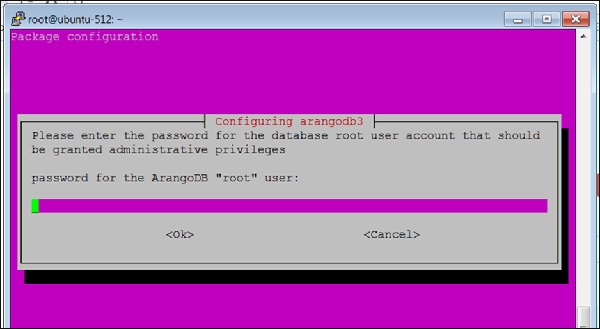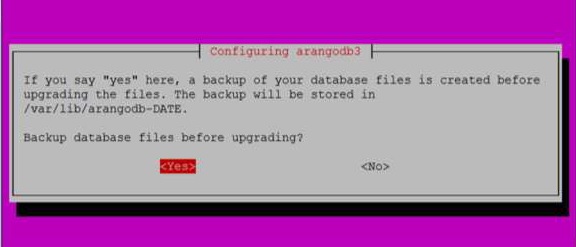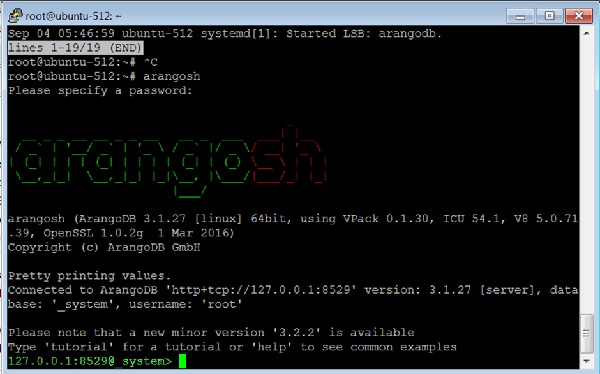ArangoDB - सिस्टम आवश्यकताएँ
इस अध्याय में, हम ArangoDB के लिए सिस्टम आवश्यकताओं पर चर्चा करेंगे।
ArangoDB के लिए सिस्टम आवश्यकताएँ निम्नानुसार हैं -
- उबंटू इंस्टॉलेशन वाला एक VPS सर्वर
- रैम: 1 जीबी; सीपीयू: 2.2 गीगाहर्ट्ज़
इस ट्यूटोरियल में सभी कमांड्स के लिए, हमने उबंटू 16.04 (xenial) का RAM 1GB RAM का उपयोग किया है, जिसमें एक सीपीयू के साथ प्रोसेसिंग पावर 2.2 गीगाहर्ट्ज़ है। और इस ट्यूटोरियल में सभी आरंगोश कमांड्स को अरंगबीडीबी संस्करण 3.1.27 के लिए परीक्षण किया गया था।
ArangoDB कैसे स्थापित करें?
इस अनुभाग में, हम देखेंगे कि अरणगोबीडी को कैसे स्थापित किया जाए। ArangoDB कई ऑपरेटिंग सिस्टम और वितरण के लिए पूर्व-निर्मित आता है। अधिक जानकारी के लिए, कृपया अरेंजबीडी प्रलेखन देखें। जैसा कि पहले ही उल्लेख किया गया है, इस ट्यूटोरियल के लिए हम Ubuntu 16.04x64 का उपयोग करेंगे।
पहला कदम अपनी रिपॉजिटरी के लिए सार्वजनिक कुंजी डाउनलोड करना है -
# wget https://www.arangodb.com/repositories/arangodb31/
xUbuntu_16.04/Release.keyउत्पादन
--2017-09-03 12:13:24-- https://www.arangodb.com/repositories/arangodb31/xUbuntu_16.04/Release.key
Resolving https://www.arangodb.com/
(www.arangodb.com)... 104.25.1 64.21, 104.25.165.21,
2400:cb00:2048:1::6819:a415, ...
Connecting to https://www.arangodb.com/
(www.arangodb.com)|104.25. 164.21|:443... connected.
HTTP request sent, awaiting response... 200 OK
Length: 3924 (3.8K) [application/pgpkeys]
Saving to: ‘Release.key’
Release.key 100%[===================>] 3.83K - .-KB/s in 0.001s
2017-09-03 12:13:25 (2.61 MB/s) - ‘Release.key’ saved [39 24/3924]महत्वपूर्ण बात यह है कि आपको देखना चाहिए Release.key आउटपुट के अंत में सहेजा गया।
कोड की निम्नलिखित पंक्ति का उपयोग करके सहेजे गए कुंजी को स्थापित करें -
# sudo apt-key add Release.keyउत्पादन
OKउपयुक्त भंडार जोड़ने और सूचकांक को अद्यतन करने के लिए निम्नलिखित कमांड्स चलाएं -
# sudo apt-add-repository 'deb
https://www.arangodb.com/repositories/arangodb31/xUbuntu_16.04/ /'
# sudo apt-get updateअंतिम चरण के रूप में, हम ArangoDB स्थापित कर सकते हैं -
# sudo apt-get install arangodb3उत्पादन
Reading package lists... Done
Building dependency tree
Reading state information... Done
The following package was automatically installed and is no longer required:
grub-pc-bin
Use 'sudo apt autoremove' to remove it.
The following NEW packages will be installed:
arangodb3
0 upgraded, 1 newly installed, 0 to remove and 17 not upgraded.
Need to get 55.6 MB of archives.
After this operation, 343 MB of additional disk space will be used.दबाएँ Enter। अब ArangoDB स्थापित करने की प्रक्रिया शुरू होगी -
Get:1 https://www.arangodb.com/repositories/arangodb31/xUbuntu_16.04
arangodb3 3.1.27 [55.6 MB]
Fetched 55.6 MB in 59s (942 kB/s)
Preconfiguring packages ...
Selecting previously unselected package arangodb3.
(Reading database ... 54209 files and directories currently installed.)
Preparing to unpack .../arangodb3_3.1.27_amd64.deb ...
Unpacking arangodb3 (3.1.27) ...
Processing triggers for systemd (229-4ubuntu19) ...
Processing triggers for ureadahead (0.100.0-19) ...
Processing triggers for man-db (2.7.5-1) ...
Setting up arangodb3 (3.1.27) ...
Database files are up-to-date.जब ArangoDB की स्थापना पूरी होने वाली है, तो निम्न स्क्रीन दिखाई देती है -

यहां, आपको ArangoDB के लिए एक पासवर्ड प्रदान करने के लिए कहा जाएगा rootउपयोगकर्ता। इसे ध्यान से देखें।
को चुनिए yes विकल्प जब निम्नलिखित संवाद बॉक्स प्रकट होता है -

जब आप क्लिक करेंगे Yesजैसा कि उपरोक्त डायलॉग बॉक्स में, निम्न डायलॉग बॉक्स दिखाई देता है। क्लिक करेंYes यहाँ।

आप निम्न कमांड के साथ अरंगबोब की स्थिति भी देख सकते हैं -
# sudo systemctl status arangodb3उत्पादन
arangodb3.service - LSB: arangodb
Loaded: loaded (/etc/init.d/arangodb3; bad; vendor pre set: enabled)
Active: active (running) since Mon 2017-09-04 05:42:35 UTC;
4min 46s ago
Docs: man:systemd-sysv-generator(8)
Process: 2642 ExecStart=/etc/init.d/arangodb3 start (code = exited,
status = 0/SUC
Tasks: 22
Memory: 158.6M
CPU: 3.117s
CGroup: /system.slice/arangodb3.service
├─2689 /usr/sbin/arangod --uid arangodb
--gid arangodb --pid-file /va
└─2690 /usr/sbin/arangod --uid arangodb
--gid arangodb --pid-file /va
Sep 04 05:42:33 ubuntu-512 systemd[1]: Starting LSB: arangodb...
Sep 04 05:42:33 ubuntu-512 arangodb3[2642]: * Starting arango database server a
Sep 04 05:42:35 ubuntu-512 arangodb3[2642]: {startup} starting up in daemon mode
Sep 04 05:42:35 ubuntu-512 arangodb3[2642]: changed working directory for child
Sep 04 05:42:35 ubuntu-512 arangodb3[2642]: ...done.
Sep 04 05:42:35 ubuntu-512 systemd[1]: StartedLSB: arang odb.
Sep 04 05:46:59 ubuntu-512 systemd[1]: Started LSB: arangodb. lines 1-19/19 (END)ArangoDB अब उपयोग के लिए तैयार है।
आरंगोश टर्मिनल का आह्वान करने के लिए, टर्मिनल में निम्नलिखित कमांड टाइप करें -
# arangoshउत्पादन
Please specify a password:की आपूर्ति root स्थापना के समय बनाया गया पासवर्ड -
_
__ _ _ __ __ _ _ __ __ _ ___ | |
/ | '__/ _ | ’ \ / ` |/ _ / | ’
| (| | | | (| | | | | (| | () _ \ | | |
_,|| _,|| ||_, |_/|/| ||
|__/arangosh (ArangoDB 3.1.27 [linux] 64bit, using VPack 0.1.30, ICU 54.1, V8
5.0.71.39, OpenSSL 1.0.2g 1 Mar 2016)
Copyright (c) ArangoDB GmbH
Pretty printing values.
Connected to ArangoDB 'http+tcp://127.0.0.1:8529' version: 3.1.27 [server],
database: '_system', username: 'root'
Please note that a new minor version '3.2.2' is available
Type 'tutorial' for a tutorial or 'help' to see common examples
127.0.0.1:8529@_system> exit
ArangoDB से लॉग आउट करने के लिए, निम्न कमांड टाइप करें -
127.0.0.1:8529@_system> exitउत्पादन
Uf wiederluege! Na shledanou! Auf Wiedersehen! Bye Bye! Adiau! ¡Hasta luego!
Εις το επανιδείν!
להתראות ! Arrivederci! Tot ziens! Adjö! Au revoir! さようなら До свидания! Até
Breve! !خداحافظ